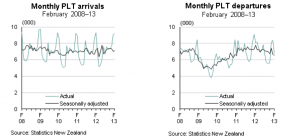When you have two numbers
Last month, Statistics New Zealand released the travel and migration statistics for January. Visits from China and Hong Kong were notably lower than the past year. This was attributed to Chinese New Year being in February. The media duly reported all this.
Now, Statistics New Zealand has released the travel and migration statistics for January. Visits from China and Hong Kong were notably higher than the past year. This was attributed to Chinese New Year being in February. The media duly reported all this.
It seems obvious that you’d want to combine the two months, so that the Chinese New Year effect drops out. I haven’t seen anyone do this yet:
- Visitors from China: Jan+Feb 2012: 23300+15300=38600
- Vistors from China: Jan+Feb 2013 18800+31500=50300
For Hong Kong the January figures aren’t in the press release, but the change is: there were 2200 more than last year in February, and 1500 fewer in January, for an increase of 700.
So, a fairly big increase in visitors from these countries over the past two years.
Net migration was also up a bit, and here I think a longer time series than the media reported would be useful. The full time series in the Stats NZ release looks like
Arrivals are pretty constant. Departures are slowly declining, but are still much higher than in the 09/10 minimum.
Thomas Lumley (@tslumley) is Professor of Biostatistics at the University of Auckland. His research interests include semiparametric models, survey sampling, statistical computing, foundations of statistics, and whatever methodological problems his medical collaborators come up with. He also blogs at Biased and Inefficient See all posts by Thomas Lumley »
